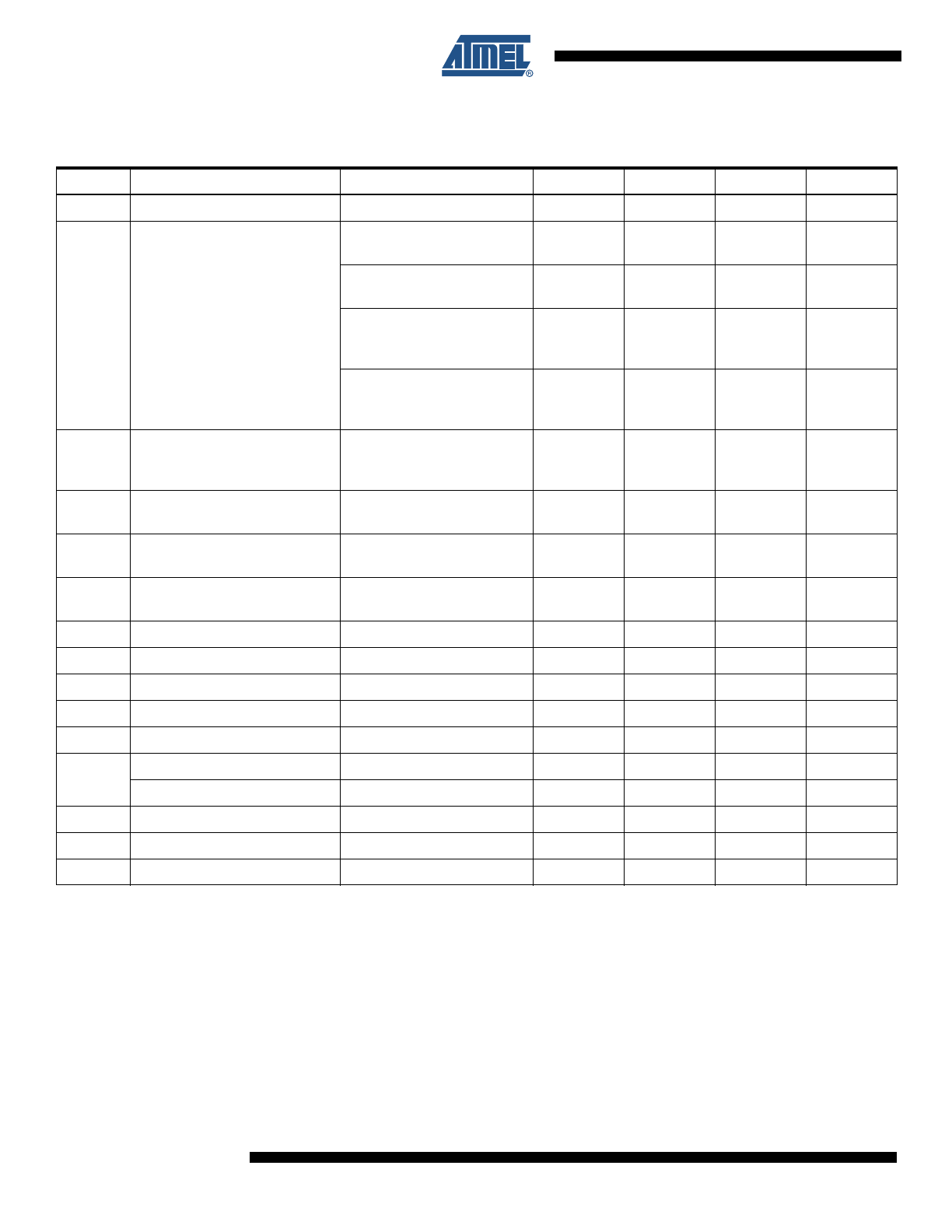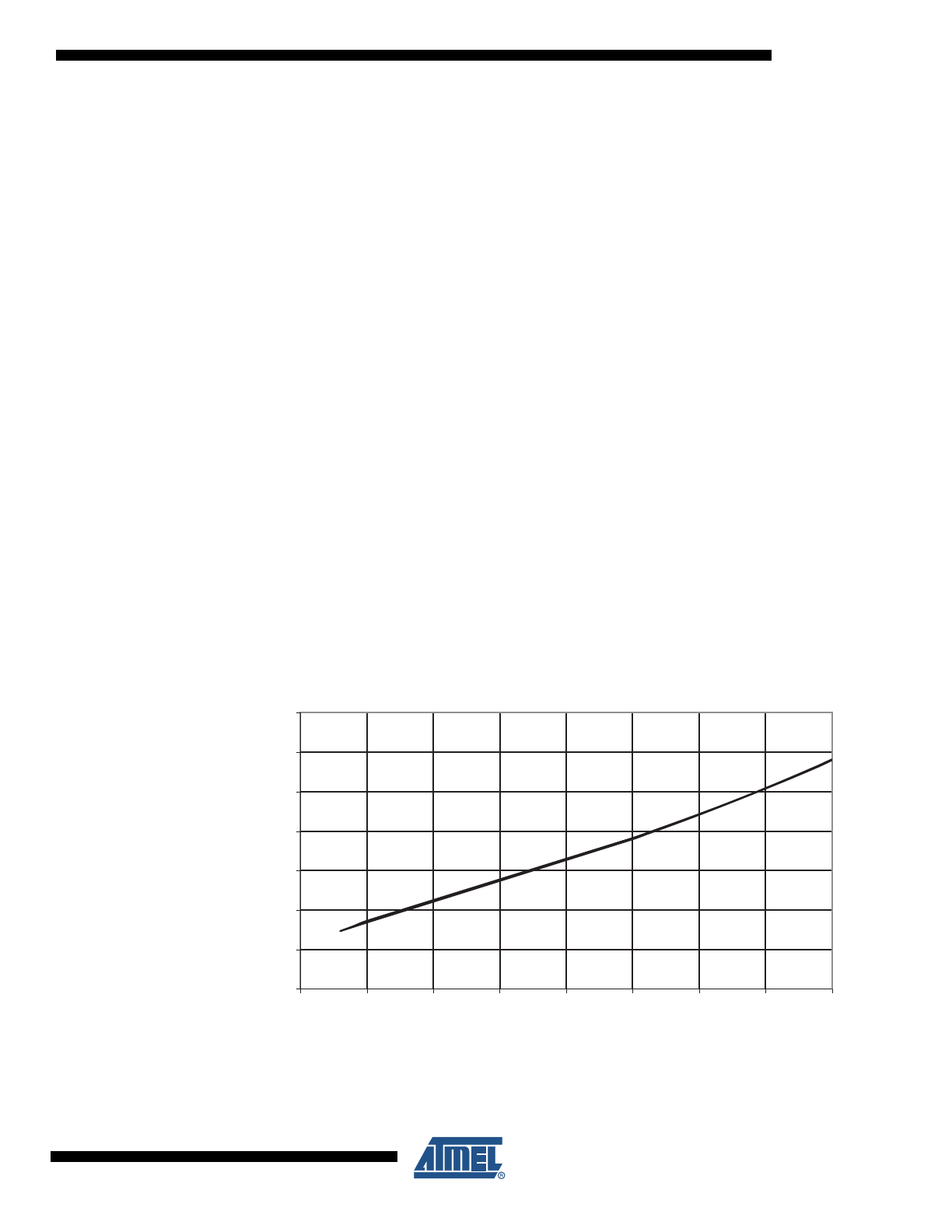
Appendix B — ATtiny25/V Specification at +125
°
C
This document contains information specific to devices operating at temperatures up
to 125°C. Only deviations are covered in this appendix, all other information can be
found in the complete datasheet. The complete datasheet can be found at
www.atmel.com.
8-bit
Microcontroller
with 2/4/8K
Bytes In-System
Programmable
Flash
ATtiny25
ATtiny25V
Appendix B
Rev. 2586N-Appendix B–AVR–08/11

2
2586N-Appendix B–AVR–08/11
ATtiny25
1.
Memories
1.1
EEPROM Data Memory
The EEPROM has an endurance of at least 50,000 write/erase cycles.

3
2586N-Appendix B–AVR–08/11
ATtiny25
2.
Electrical Characteristics
2.1
DC Characteristics
Notes:
1. Typical values at 25
°
C.
2. “Min” means the lowest value where the pin is guaranteed to be read as high.
3. “Max” means the highest value where the pin is guaranteed to be read as low.
Table 2-1.
DC Characteristics. T
A
= -40
°
C to +125
°
C
Symbol
Parameter
Condition
Min.
Typ.
(1)
Max.
Units
V
IL
Input Low-voltage, except
XTAL1 and RESET pin
V
CC
= 1.8V - 2.4V
V
CC
= 2.4V - 5.5V
-0.5
-0.5
0.2V
CC
(3)
0.3V
CC
(3)
V
V
V
IH
Input High-voltage, except
XTAL1 and RESET pin
V
CC
= 1.8V - 2.4V
V
CC
= 2.4V - 5.5V
0.7V
CC
(2)
0.6V
CC
(2)
V
CC
+0.5
V
CC
+0.5
V
V
V
IL1
Input Low-voltage, XTAL1 pin,
External Clock Selected
V
CC
= 1.8V - 5.5V
-0.5
0.1V
CC
(3)
V
V
IH1
Input High-voltage, XTAL1 pin,
External Clock Selected
V
CC
= 1.8V - 2.4V
V
CC
= 2.4V - 5.5V
0.8V
CC
(2)
0.7V
CC
(2)
V
CC
+0.5
V
CC
+0.5
V
V
V
IL2
Input Low-voltage,
RESET pin
V
CC
= 1.8V - 5.5V
-0.5
0.2V
CC
(3)
V
V
V
IH2
Input High-voltage,
RESET pin
V
CC
= 1.8V - 5.5V
0.9V
CC
(2)
V
CC
+0.5
V
V
IL3
Input Low-voltage,
RESET pin as I/O
V
CC
= 1.8V - 2.4V
V
CC
= 2.4V - 5.5V
-0.5
-0.5
0.2V
CC
(3)
0.3V
CC
(3)
V
V
V
IH3
Input High-voltage,
RESET pin as I/O
V
CC
= 1.8V - 2.4V
V
CC
= 2.4V - 5.5V
0.7V
CC
(2)
0.6V
CC
(2)
V
CC
+0.5
V
CC
+0.5
V
V
V
OL
Output Low-voltage,
(4)
Port B (except RESET)
(6)
I
OL
= 10 mA, V
CC
= 5V
I
OL
= 5 mA, V
CC
= 3V
0.6
0.5
V
V
V
OH
Output High-voltage,
(5)
Port B (except RESET)
(6)
I
OH
= -10 mA, V
CC
= 5V
I
OH
= -5 mA, V
CC
= 3V
4.3
2.5
V
V
I
IL
Input Leakage
Current I/O Pin
V
CC
= 5.5V, pin low
(absolute value)
< 0.05
1
µA
I
IH
Input Leakage
Current I/O Pin
V
CC
= 5.5V, pin high
(absolute value)
< 0.05
1
µA
R
RST
Reset Pull-up Resistor
V
CC
= 5.5V, input low
30
60
k
Ω
R
pu
I/O Pin Pull-up Resistor
V
CC
= 5.5V, input low
20
50
k
Ω
I
CC
Power Supply Current
(7)
Active 1 MHz, V
CC
= 2V
0.3
0.55
mA
Active 4 MHz, V
CC
= 3V
1.5
2.5
mA
Active 8 MHz, V
CC
= 5V
5
8
mA
Idle 1 MHz, V
CC
= 2V
0.1
0.2
mA
Idle 4 MHz, V
CC
= 3V
0.35
0.6
mA
Idle 8 MHz, V
CC
= 5V
1.2
2
mA
Power-down mode
(8)
WDT enabled, V
CC
= 3V
4
20
µA
WDT disabled, V
CC
= 3V
0.2
14
µA

4
2586N-Appendix B–AVR–08/11
ATtiny25
4. Although each I/O port can sink more than the test conditions (10 mA at V
CC
= 5V, 5 mA at V
CC
= 3V) under steady state
conditions (non-transient), the sum of all I
OL
, for all ports, should not exceed 60 mA. If I
OL
exceeds the test condition, V
OL
may exceed the related specification. Pins are not guaranteed to sink current greater than the listed test condition.
5. Although each I/O port can source more than the test conditions (10 mA at V
CC
= 5V, 5 mA at V
CC
= 3V) under steady state
conditions (non-transient), the sum of all I
OH
, for all ports, should not exceed 60 mA. If I
OH
exceeds the test condition, V
OH
may exceed the related specification. Pins are not guaranteed to source current greater than the listed test condition.
6. The RESET pin must tolerate high voltages when entering and operating in programming modes and, as a consequence,
has a weak drive strength as compared to regular I/O pins. See
Figure 3-19
,
Figure 3-20
,
Figure 3-21
, and
Figure 3-22
(starting on
page 18
).
7. Values are with external clock using methods described in
“Minimizing Power Consumption” on page 37
. Power Reduction is
enabled (PRR = 0xFF) and there is no I/O drive.
8. Brown-Out Detection (BOD) disabled.
2.2
Clock Characteristics
2.2.1
Calibrated Internal RC Oscillator Accuracy
It is possible to manually calibrate the internal oscillator to be more accurate than default factory
calibration. Please note that the oscillator frequency depends on temperature and voltage. Volt-
age and temperature characteristics can be found in
Figure 3-36 on page 27
and
Figure 3-37 on
page 27
.
Notes:
1. Accuracy of oscillator frequency at calibration point (fixed temperature and fixed voltage).
2. 6.4 MHz in ATtiny15 Compatibility Mode.
3. Voltage range for ATtiny25V.
4. Voltage range for ATtiny25.
2.3
System and Reset Characteristics
2.3.1
Power-On Reset
Note:
1. Values are guidelines, only
2. Threshold where device is released from reset when voltage is rising
3. The Power-on Reset will not work unless the supply voltage has been below V
POT
(falling)
Table 2-2.
Calibration Accuracy of Internal RC Oscillator
Calibration
Method
Target Frequency
V
CC
Temperature
Accuracy at given Voltage
& Temperature
(1)
Factory Calibration
8.0 MHz
(2)
3V
25
°
C
±10%
User
Calibration
Fixed frequency within:
6 – 8 MHz
Fixed voltage within:
1.8V - 5.5V
(3)
2.7V - 5.5V
(4)
Fixed temperature
within:
-40
°
C to +125
°
C
±1%
Table 2-3.
Characteristics of Power-On Reset. T
A
= -40
°
C to +125
°
C
Symbol
Parameter
Min
(1)
Typ
(1)
Max
(1)
Units
V
POR
Release threshold of power-on reset
(2)
1.1
1.4
1.7
V
V
POA
Activation threshold of power-on reset
(3)
0.6
1.3
1.7
V
SR
ON
Power-On Slope Rate
0.01
V/ms

5
2586N-Appendix B–AVR–08/11
ATtiny25
2.4
Brown-Out Detection
Note:
1. V
BOT
may be below nominal minimum operating voltage for some devices. For devices where
this is the case, the device is tested down to V
CC
= V
BOT
during the production test. This guar-
antees that a Brown-out Reset will occur before V
CC
drops to a voltage where correct
operation of the microcontroller is no longer guaranteed.
2.5
Serial Programming Characteristics
Note:
1. 2 t
CLCL
for f
ck
< 12 MHz, 3 t
CLCL
for f
ck
>= 12 MHz
Table 2-4.
BODLEVEL Fuse Coding. T
A
= -40
°
C to +125
°
C
BODLEVEL[2:0] Fuses
Min
(1)
Typ
(1)
Max
(1)
Units
111
BOD Disabled
110
1.7
1.8
2.0
V
101
2.5
2.7
2.9
100
4.1
4.3
4.5
0XX
Reserved
Table 2-5.
Serial Programming Characteristics, T
A
= -40
°
C to +125
°
C, V
CC
= 1.8 - 5.5V
(Unless Otherwise Noted)
Symbol
Parameter
Min
Typ
Max
Units
1/t
CLCL
Oscillator Frequency (V
CC
= 1.8 - 5.5V)
0
4
MHz
t
CLCL
Oscillator Period (V
CC
= 1.8 - 5.5V)
250
ns
1/t
CLCL
Oscillator Frequency (V
CC
= 2.7 - 5.5V)
0
10
MHz
t
CLCL
Oscillator Period (V
CC
= 2.7 - 5.5V)
100
ns
1/t
CLCL
Oscillator Frequency (V
CC
= 4.5V - 5.5V)
0
20
MHz
t
CLCL
Oscillator Period (V
CC
= 4.5V - 5.5V)
50
ns
t
SHSL
SCK Pulse Width High
2 t
CLCL*
ns
t
SLSH
SCK Pulse Width Low
2 t
CLCL*
ns
t
OVSH
MOSI Setup to SCK High
t
CLCL
ns
t
SHOX
MOSI Hold after SCK High
2 t
CLCL
ns
t
SLIV
SCK Low to MISO Valid
100
ns

6
2586N-Appendix B–AVR–08/11
ATtiny25
2.6
ADC Characteristics
Note:
1. Values are guidelines only.
Table 2-6.
ADC Characteristics, Single Ended Channels. T
A
= -40
°
C to +125
°
C
Symbol
Parameter
Condition
Min
Typ
Max
Units
Resolution
10
Bits
Absolute accuracy
(Including INL, DNL, and
Quantization, Gain and
Offset errors)
V
REF
= 4V, V
CC
= 4V,
ADC clock = 200 kHz
2
LSB
V
REF
= 4V, V
CC
= 4V,
ADC clock = 1 MHz
3
LSB
V
REF
= 4V, V
CC
= 4V,
ADC clock = 200 kHz
Noise Reduction Mode
1.5
LSB
V
REF
= 4V, V
CC
= 4V,
ADC clock = 1 MHz
Noise Reduction Mode
2.5
LSB
Integral Non-linearity (INL)
(Accuracy after offset and gain
calibration)
V
REF
= 4V, V
CC
= 4V,
ADC clock = 200 kHz
1
LSB
Differential Non-linearity (DNL)
V
REF
= 4V, V
CC
= 4V,
ADC clock = 200 kHz
0.5
LSB
Gain Error
V
REF
= 4V, V
CC
= 4V,
ADC clock = 200 kHz
2.5
LSB
Offset Error
V
REF
= 4V, V
CC
= 4V,
ADC clock = 200 kHz
1.5
LSB
Conversion Time
Free Running Conversion
14
280
µs
Clock Frequency
50
1000
kHz
V
IN
Input Voltage
GND
V
REF
V
Input Bandwidth
38.4
kHz
AREF
External Reference Voltage
2.0
V
CC
V
V
INT
Internal Voltage Reference
1.0
1.1
1.2
V
Internal 2.56V Reference
(1)
V
CC
> 3.0V
2.3
2.56
2.8
V
R
REF
32
k
Ω
R
AIN
Analog Input Resistance
100
M
Ω
ADC Output
0
1023
LSB

7
2586N-Appendix B–AVR–08/11
ATtiny25
Note:
1. Values are guidelines only.
Table 2-7.
ADC Characteristics, Differential Channels (Unipolar Mode). T
A
= -40
°
C to +125
°
C
Symbol
Parameter
Condition
Min
Typ
Max
Units
Resolution
Gain = 1x
10
Bits
Gain = 20x
10
Bits
Absolute accuracy
(Including INL, DNL, and
Quantization, Gain and Offset
Errors)
Gain = 1x
V
REF
= 4V, V
CC
= 5V
ADC clock = 50 - 200 kHz
10.0
LSB
Gain = 20x
V
REF
= 4V, V
CC
= 5V
ADC clock = 50 - 200 kHz
20.0
LSB
Integral Non-Linearity (INL)
(Accuracy after Offset and
Gain Calibration)
Gain = 1x
V
REF
= 4V, V
CC
= 5V
ADC clock = 50 - 200 kHz
4.0
LSB
Gain = 20x
V
REF
= 4V, V
CC
= 5V
ADC clock = 50 - 200 kHz
10.0
LSB
Gain Error
Gain = 1x
10.0
LSB
Gain = 20x
15.0
LSB
Offset Error
Gain = 1x
V
REF
= 4V, V
CC
= 5V
ADC clock = 50 - 200 kHz
3.0
LSB
Gain = 20x
V
REF
= 4V, V
CC
= 5V
ADC clock = 50 - 200 kHz
4.0
LSB
Conversion Time
Free Running Conversion
70
280
µs
Clock Frequency
50
200
kHz
V
IN
Input Voltage
GND
V
CC
V
V
DIFF
Input Differential Voltage
V
REF
/Gain
V
Input Bandwidth
4
kHz
AREF
External Reference Voltage
2.0
V
CC
- 1.0
V
V
INT
Internal Voltage Reference
1.0
1.1
1.2
V
Internal 2.56V Reference
(1)
V
CC
> 3.0V
2.3
2.56
2.8
V
R
REF
Reference Input Resistance
32
k
Ω
R
AIN
Analog Input Resistance
100
M
Ω
ADC Conversion Output
0
1023
LSB

8
2586N-Appendix B–AVR–08/11
ATtiny25
Note:
1. Values are guidelines only.
Table 2-8.
ADC Characteristics, Differential Channels (Bipolar Mode). T
A
= -40
°
C to +125
°
C
Symbol
Parameter
Condition
Min
Typ
Max
Units
Resolution
Gain = 1x
10
Bits
Gain = 20x
10
Bits
Absolute accuracy
(Including INL, DNL, and
Quantization, Gain and Offset
Errors)
Gain = 1x
V
REF
= 4V, V
CC
= 5V
ADC clock = 50 - 200 kHz
8.0
LSB
Gain = 20x
V
REF
= 4V, V
CC
= 5V
ADC clock = 50 - 200 kHz
8.0
LSB
Integral Non-Linearity (INL)
(Accuracy after Offset and
Gain Calibration)
Gain = 1x
V
REF
= 4V, V
CC
= 5V
ADC clock = 50 - 200 kHz
4.0
LSB
Gain = 20x
V
REF
= 4V, V
CC
= 5V
ADC clock = 50 - 200 kHz
5.0
LSB
Gain Error
Gain = 1x
4.0
LSB
Gain = 20x
5.0
LSB
Offset Error
Gain = 1x
V
REF
= 4V, V
CC
= 5V
ADC clock = 50 - 200 kHz
3.0
LSB
Gain = 20x
V
REF
= 4V, V
CC
= 5V
ADC clock = 50 - 200 kHz
4.0
LSB
Conversion Time
Free Running Conversion
70
280
µs
Clock Frequency
50
200
kHz
V
IN
Input Voltage
GND
V
CC
V
V
DIFF
Input Differential Voltage
V
REF
/Gain
V
Input Bandwidth
4
kHz
AREF
External Reference Voltage
2.0
V
CC
- 1.0
V
V
INT
Internal Voltage Reference
1.0
1.1
1.2
V
Internal 2.56V Reference
(1)
V
CC
> 3.0V
2.3
2.56
2.8
V
R
REF
Reference Input Resistance
32
k
Ω
R
AIN
Analog Input Resistance
100
M
Ω
ADC Conversion Output
-512
511
LSB

9
2586N-Appendix B–AVR–08/11
ATtiny25
3.
Typical Characteristics
The data contained in this section is largely based on simulations and characterization of similar
devices in the same process and design methods. Thus, the data should be treated as indica-
tions of how the part will behave.
The following charts show typical behavior. These figures are not tested during manufacturing.
All current consumption measurements are performed with all I/O pins configured as inputs and
with internal pull-ups enabled. A sine wave generator with rail-to-rail output is used as clock
source.
The power consumption in Power-down mode is independent of clock selection.
The current consumption is a function of several factors such as: operating voltage, operating
frequency, loading of I/O pins, switching rate of I/O pins, code executed and ambient tempera-
ture. The dominating factors are operating voltage and frequency.
The current drawn from capacitive loaded pins may be estimated (for one pin) as C
L
*
V
CC
*f
where C
L
= load capacitance, V
CC
= operating voltage and f = average switching frequency of
I/O pin.
The parts are characterized at frequencies higher than test limits. Parts are not guaranteed to
function properly at frequencies higher than the ordering code indicates.
The difference between current consumption in Power-down mode with Watchdog Timer
enabled and Power-down mode with Watchdog Timer disabled represents the differential cur-
rent drawn by the Watchdog Timer.
3.1
Active Supply Current
Figure 3-1.
Active Supply Current vs. V
CC
(Internal RC oscillator, 8 MHz)
125 °C
25 °C
-40 °C
0
1
2
3
4
5
6
7
1.5
2
2.5
3
3
.5
4
4.5
5
5.5
V
CC
(V)
I
CC
(mA)

10
2586N-Appendix B–AVR–08/11
ATtiny25
Figure 3-2.
Active Supply Current vs. V
CC
(Internal RC Oscillator, 1 MHz)
Figure 3-3.
Active Supply Current vs. V
CC
(Internal RC Oscillator, 128 kHz)
125 °C
25 °C
-40 °C
0
0.2
0.4
0.6
0.
8
1
1.2
1.4
1.6
1.5
2
2.5
3
3
.5
4
4.5
5
5.5
V
CC
(V)
I
CC
(mA)
125 °C
25 °C
-40 °C
0
0.05
0.1
0.15
0.2
0.25
1.5
2
2.5
3
3
.5
4
4.5
5
5.5
V
CC
(V)
I
CC
(mA)
